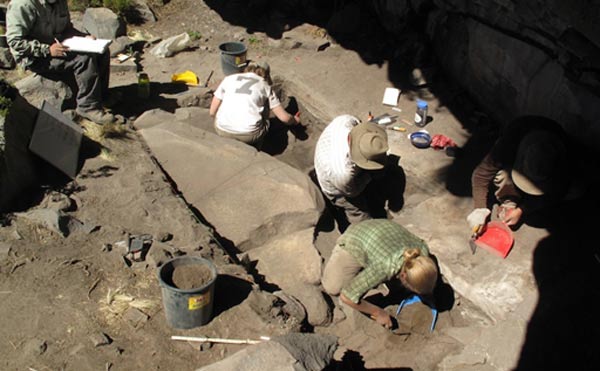12,800-year-old campsite found at extreme altitude in Peruvian Andes
A new report published in the journal Science has revealed the discovery of an ancient shelter, rock art, and a tool workshop at an altitude of nearly 14,700 feet (4,500 meters) above sea level. Dating back around 12,800 years, the prehistoric site is the oldest known evidence of humans living at an extreme altitude.
The discovery was made by archaeologist Kurt Rademaker and geologist Gordon Bromley in the Pucuncho Basin, a cold and arid plateau ringed by 21,000-foot-tall (6,400 meters) volcanoes in the southern Peruvian Andes. They had previously found arrowheads at 4,355 meters, pointing to the possibility of finding Paleoindian settlements at high-altitude.

Research has revealed that Paleoindians made settlements at extremely high altitude in the Andes mountains. (Wikipedia)
Over the course of several years since 2009, Rademaker and colleagues uncovered hundreds of stone tools and projectile points at three archaeological sites in the Pucuncho Basin and now, they have uncovered an ancient base camp. The settlement consists of a shelter containing rock art, ceilings covered in soot from campfires, plant remains that came from lower elevations, animal bones, and a nearby open air tool-making workshop. Testing revealed that the tools date back as far as 12,800 years ago, while there is evidence that the campsite was in use for thousands of years from around 12,400 years ago.

A Paleoindian campsite. (Goldposters)
The findings suggest people were living at high altitudes earlier than previously thought – just 2,000 years after humans supposedly reached the continent. This raises questions about how these early settlers physically adapted to such a high altitude – at such extreme altitudes, humans risk dying of hypoxia (lack of oxygen) and other associated complications.
"Either they genetically adapted really, really fast — within 2,000 years — to be able to settle this area, or genetic adaptation isn't necessary at all," said Rademaker. A third hypothesis not mentioned by the study authors is that humans inhabited the region much earlier than 15,000 years ago.
Featured image: Archaeologists excavate a rockshelter in the Peruvian Andes that was used more than 12,000 years ago by human settlers. Credit: Kurt Rademaker


















Comments
I'm still also wondering why people would want to live up so high....weren't people more nomadic in the time period being described? Why stay in what I can only imagine would not be the greatest of conditions for living, building and growing...clearly they thrived though, for a long time. Reminds me a bit of Machu Picchu...high up, also has terraces.
love, light and blessings
AB
Evidence like this makes me question the Bering Strait theory as the de jure origin of the Indigenous Peoples of the Americas. I have also read of sights in the Amazon that go back forty-thousand years. Somehow, it seems the origin of humans is more complex everywhere you look, and we are discovering that everyday. A beautiful time to live and discover.
Well i was thinking if that alternate theory "may b they don't need to adapt at all"..may be the ancient gene pool already contains tge solution for high altitude adaprion, as the remnants we can see in ppl living in moutain high altitude niw a days..,and most of the clans living in plains eventually lost those ,just happened in case of most useful wild genes of plants after domistication! Lets wait for d next papers!
Inventor,
As usual, you make excellent points in your post. I had not considered the matter of engineering necessary for such structures to survive so long relatively intact. You are absolutely correct, these structures are not trivial things.
The observation regarding the great great great grandfather's house foundations made me laugh. It's hilarious, but again, you are absolutely correct.
Interesting that Sweden also has such terracing! I didn't know that.
Tsurugi
For these terraces to still be visible, they would have been constructed with keen regard of the hydraulic mecanism of it all. Otherwhise erosion ( any kind of erosion) would have eliminated all traces of it in less than a thousand years. Why can´t we appreciate that all these terraced areas took a lot more of knowledge and effort than what we tend to credit it for. As well, much would point towards that climate have changed more drastically over time.
There even is remains of terraces in Sweden in some places, that partly have resisted the icesheat during the iceage. The tales that say that those where constructed by someones great great grandfather, isn´t true. I say it isn´t, by looking at those great great grandfathers house foundations, which all look awful and primitive. When assesing and calculating on the walls that keep the terraces in place, you easily find that it is hundreds or thousands of tons of stone in each stretch. To me, it all indicates both that climate zones have moved and that knowledge and resource that once was present in these places was impressive.
Pages